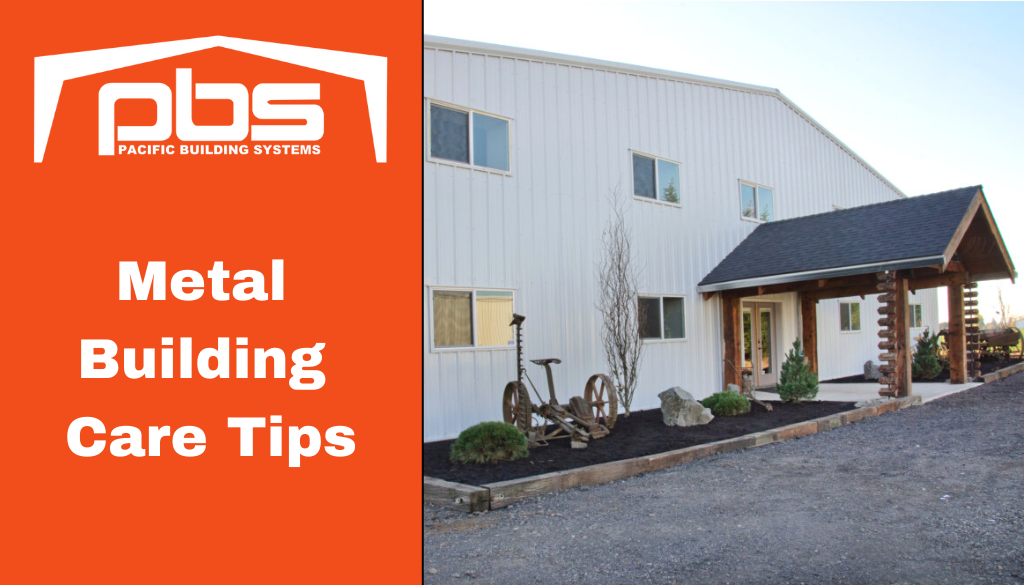How to Care for Your Metal Building
5 essential building care tips from the
professionals at Pacific Building Systems
A straightforward piece of advice: if you take care of things, they last! This is often said when referring to things like clothing, cars, family heirlooms, or ourselves. But this is versatile advice which applies to nearly everything.
Even structures like pre engineered steel buildings, which already have long lifespans, will benefit from consistent care throughout the years.
Read on to learn how to care for your building during inclement weather, when cosmetic issues arise, and when you need to swap out a few parts swiftly and smoothly.
Metal Building Care Tip #2: Cosmetic Fixes
Though cosmetic issues such as scratches or fading don’t necessarily cause damage, over the long term this wear and tear can cause rust or weaken parts of your building. Deal with cosmetic issues when they show up to avoid larger problems down the road.
Things like peeling paint or scratches can be more concerning in some environments. Cosmetic damage to buildings in locales which experience high humidity, heavy snow or rain may be prone to developing rust. Rust can eventually damage the structural integrity of a building, so it’s pertinent to manage and prevent rusting at the beginning.
Sealants work wonders at providing a protective layer for your steel building. Depending on the sealant, they can be applied over paint or on unfinished surfaces before paint. Sealants can provide moisture barriers, prevent rusting, and protect from harmful UV rays.
Paints are another great way to keep your steel protected from exposure. Not only can they provide rust and moisture barriers, paints allow you to play with creativity and design. Oil and enamel based paints are the best choice for pre engineered steel buildings.
If your building has developed any rusting, it’s important to remove this completely by stripping or sanding it before applying paints or sealants over the top.
Metal Building Care Tip #3: Caring for a Metal Building in Extreme Heat
Many areas have been experiencing extreme heat waves in recent years, making heat another factor to consider for long term care of your metal building.
In most cases, heat shouldn’t be a worry for the structural integrity of your building. If you are in an area that experiences extreme heat or fire danger, it’s good to consider how this can affect your building’s exterior durability and interior use.
While sunlight usually isn’t hot enough to warp steel, fire damage can weaken and warp steel. Many buildings catch fire from blocked gutters holding flammable debris. This marks the importance of regular maintenance!
Some paints and sealants are more capable of withstanding high heat, offering protection for a longer period of time. Darker colors absorb more heat, so choose a lighter finish in hotter climates.
Ensuring the interior of your building stays at a comfortable temperature will help it stay functional throughout the seasons. This means weatherproofing doors and windows according to your environment, and installing proper heating and cooling systems.
Metal Building Care Tip #4: Building Placement
Building placement is a factor many people may consider for aesthetic reasons without considering the effect on the building’s longevity. While many environmental factors such as climate conditions are not within our control, we can make some choices to prevent wear and tear or unnecessary damage to our buildings.
If you have the privilege to consider multiple locations, it’s best to avoid obvious dangers such as floodplains or locations which may experience landslides or heavy erosion. Always ensure a solid foundation that takes into account the soil structure and future environmental risks of the location.
Avoid building too close to existing trees, or planting trees without proper consideration of their growth pattern. Tree’s roots are surprisingly tough and can negatively impact foundations. Their branches can become hazardous in a few ways as well.
If trees are close enough to rub against your building, whether on a regular basis or during high winds, the paint or sealant is likely to suffer. Similarly, storms and heavy snows can cause branches or even tree trunks to break. This risks impact if the trees are near your building. You can always have an arborist inspect trees to make sure they are healthy and provide safe practice tips regarding possible pruning.
Though less of an overall risk, areas that experience heavy snow often use salt to help clear walkways and roads. If this is a practice in your area, consider proximity of your building to regularly salted paths. Salt is a corrosive substance that can eventually cause rust.
Metal Building Care Tip #5: Keeping it Clean
As noted at the start, if you take care of things they last longer! This advice tracks when it comes to keeping things clean.
Cleaning dust and debris from any mechanical components your building has–such as gears, bearings, tracks or pulleys– will help those mechanisms function smoother over the long-term.
Washing the exterior of your building and keeping the interior free of excessive dust or moisture will also add to the longevity of your structure.
There are many things you can do to keep your metal building in good shape throughout the years. Regularly inspecting your building will help you catch any concerns before they become problems. Simple care routines and pre-emptive planning can make a huge difference in ensuring your metal building lasts a lifetime.
If you have additional questions about how to maintain the life of your pre engineered metal building, reach out to us about it. We’re here to help your metal building last for the long term!
Ready to get started?
We have what it takes to make your next project a reality.
Contact a project consultant today.

